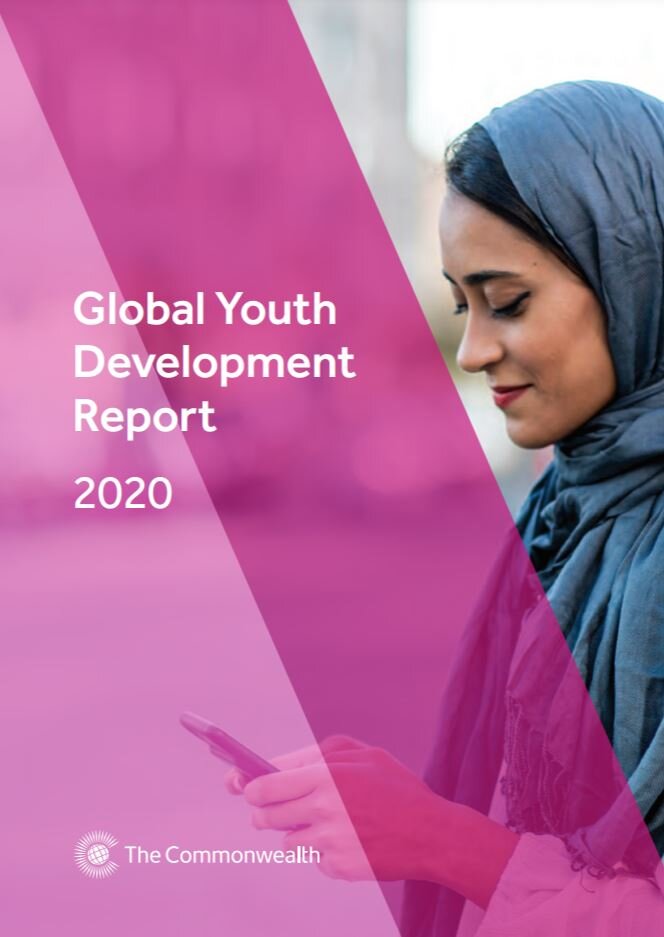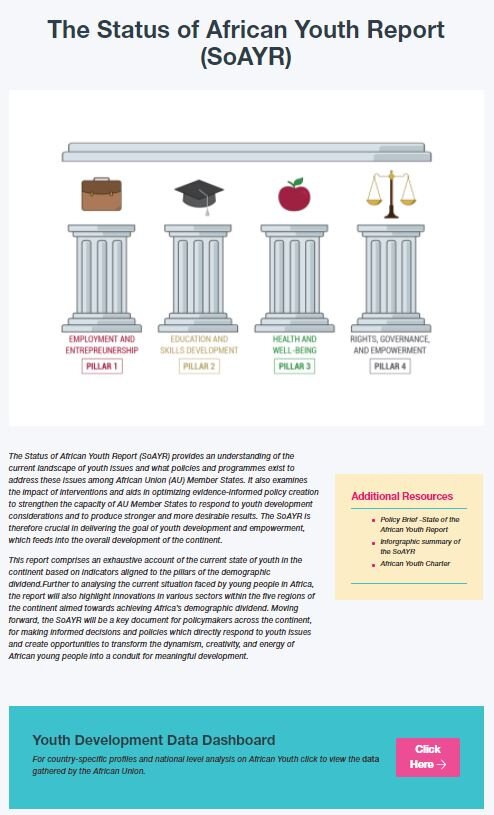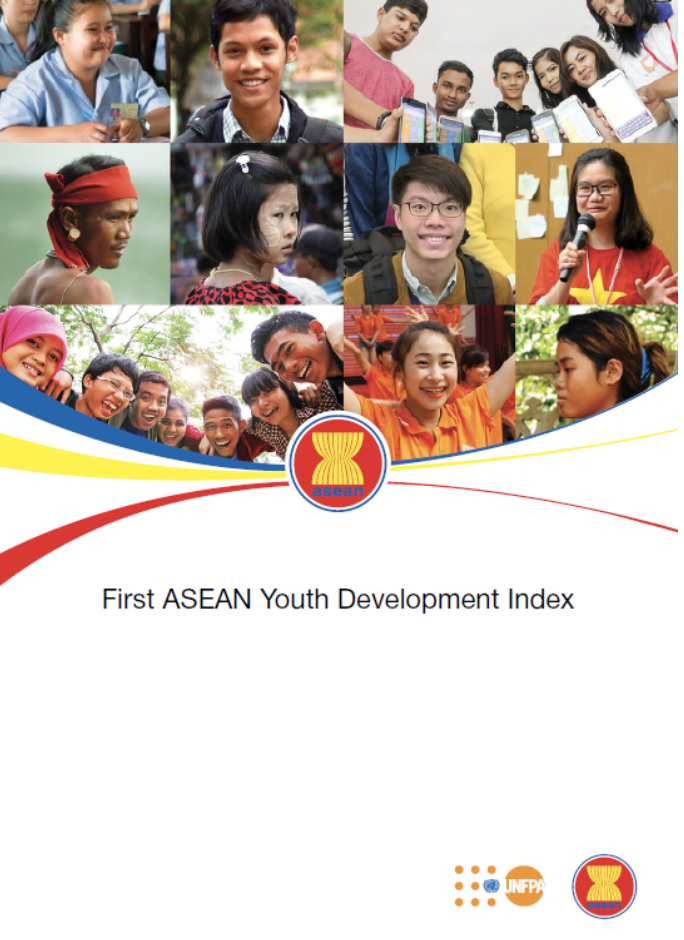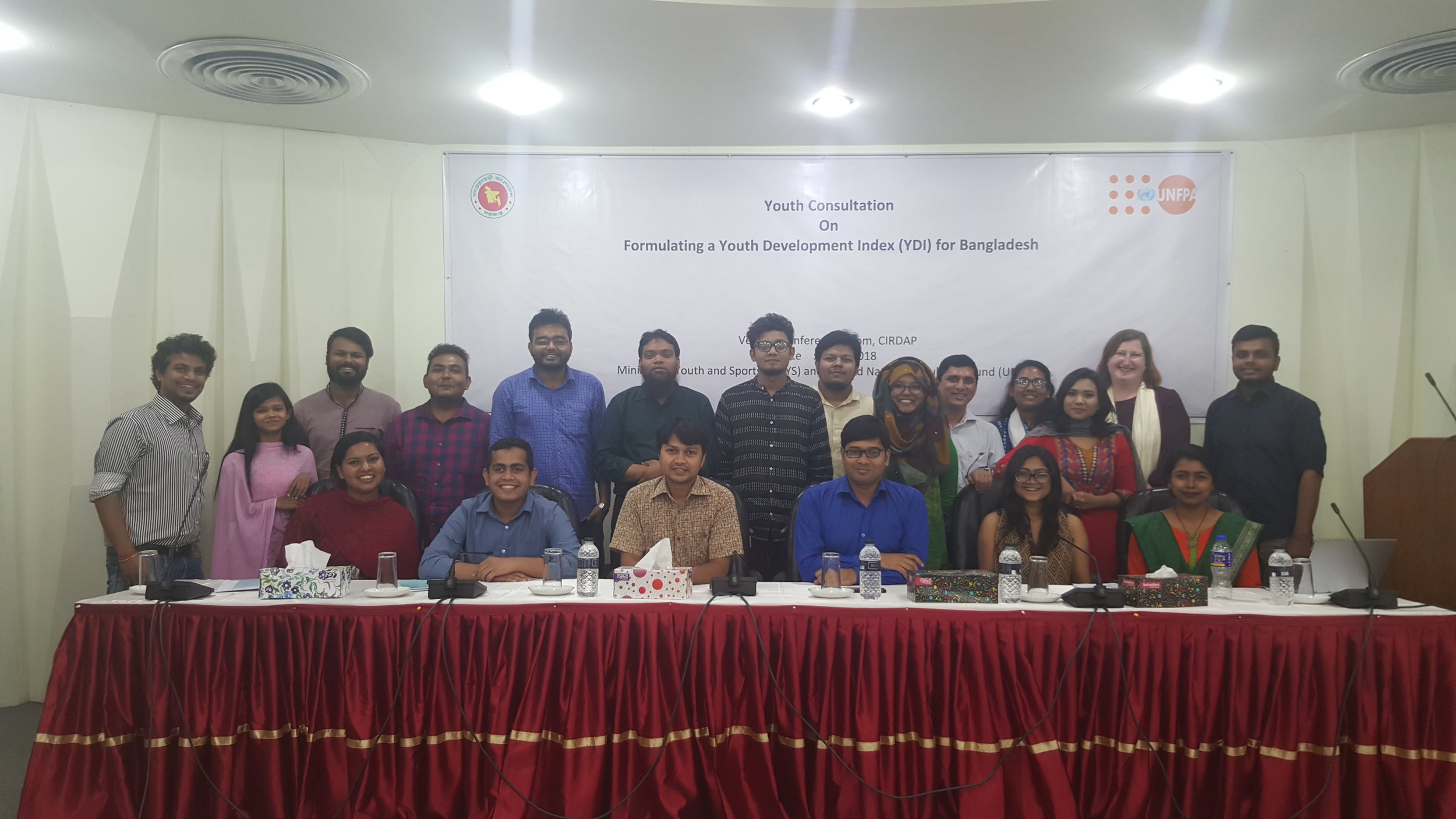Recent Releases
ASEAN YOUTH DEVELOPMENT INDEX 2022
The 2nd ASEAN YDI was built on the previous report by incorporating lessons learned from youth development initiatives globally using the previously defined youth age range of 15 to 35 years. NAPS partnered with UNFPA Asia and the Pacific and The ASEAN Secretariat on this edition to included some indicators from the first report and provided a decade’s worth of longitudinal data covering 2013 to 2022. This release also used seven domains of study; the new ones are equity and inclusion and security and safety, while the rest – education and skills, health and well-being, employment and opportunity, participation and engagement, and ASEAN Values and identity – were lifted from the first YDI.
This strategic initiative involved active engagement with key stakeholders to complement statistical indicators. Insights were gathered from the young people themselves as well as youth-led organisations to glean first-hand information on the challenges faced by youth in the region. Please click on the picture to download the report.
AUSTRALIAN YOUTH DEVELOPMENT INDEX 2020
The 2nd Australian Youth Development Index is an instrument that highlights progress in youth development in Australia and its jurisdictions. It contributes to the the design and implementation of youth policies.
NAPS partnered with the Australian Youth Affairs Coalition (AYAC), the Australian non-government national youth affairs peak body, and Jurisdictional peak bodies to develop the 2nd Australian Youth Development Index (YDI). This project included multiple youth consultations in each jurisdiction to ensure youth voice is present through out the design and construction of the YDI.
By compiling the available youth-related datasets into one comprehensive and harmonised measure, the AYDI will enable users to gain a better understanding of youth development in a single snapshot. Additionally, the research that informs the index also enables users to identify the areas in which collection of data on young people needs to be strengthened or expanded. The AYDI will make it possible to compare the status and well-being of young people living in each State and Territory.
Multiple workshops and presentations have been given to government and NGOs. Following a session at the Youth Health Summit, run by the Consumers Health Forum, and article was published in Health Voices and can be found at https://healthvoices.org.au/volume/issues/nov-2021/
GLOBAL DEVELOPMENT INDEX 2020
NAP was on the Expert Panel for the GYDI and led sessions on methodology as well as youth consultation and Regional and National YDIs.
A section, Youth Consultation in National and Regional YDIs, by Gemma Wood, Co-Founder/Principal Statistician, Numbers and People Synergy can be found on page 66 of the report.
NAPS has also been working with Communities in Numbers, in estimating the impact of policy change on indicators in the YDI. To date this has focused on education policy change and its impact on literacy rates.
Please click on the picture to download the report. More tools are available from https://youth-development-index.thecommonwealth.org/
Current and Recent Projects
PAKISTAN YOUTH DEVELOPMENT INDEX AND YOUTH POLICY LAB
The Pakistan Youth Development Index (PYDI) is composed of key indicators that measure youth development across the country. The Index utilises local data to illustrate levels of youth development in Pakistan and its sub-national regions, while also offering an analysis of the key trends and movements within the various Domains.
NAPS developed the PYDI in line with other prominent global indicators. The PYDI provides a tool for stakeholders to inform policy development and government decision-making and also serve to capture quality data and track progress over time.
A dashboard with the data has also been developed and can be found at the following link DASHBOARD
NAPS is also partnering with UNDP to develop a Youth Policy Lab which includes both youth policy development, implementation plans, evaluation plans and general data literacy. Training to Provincial governments and NGOs on use of the National Youth Survey, which NAPS developed, is being delivered both live and as instructional videos using accessible dashboards NAPS has consulted on.
NAPS has provided survey design and feedback for the National Youth Survey and a youth mental health survey.
WORLD YOUTH REPORT 2022
This work is ongoing. The Division for Inclusive Social Development of the United Nations Department of Economic and Social Affairs is preparing the World Youth Report 2022 - Improving Youth Wellbeing and Mental Health: The Role of Inclusive Social Policies. The report will address six dimensions of a young person’s life and factors that influence youth wellbeing in each context: education, decent work, family and relationships, poverty/deprivation, technology/online environment, and society. Based on real-life youth experiences and perspectives, risk and enabling factors will be analysed to identify the role of policies and examine the interlinked nature of these policies.
NAPS is facilitating the consultations with young people across diverse backgrounds and different geographic areas on the topic of mental health and wellbeing. NAPS developed a perception survey to collect the views of young people in addition to hearing directly from young people in focus groups and individual interviews with young people across the world.
EVALUATION OF FUNCTIONAL FAMILY THERAPY – CHILD WELFARE
This work is going. Functional Family Therapy - Child Welfare (FFT-CW) Australian Capital Territory (ACT) is implemented by OzChild in partnership with Gugan Gulwan Youth Aboriginal Corporation, and aims to support Aboriginal and Torres Strait Islander families to discover and grow their own strengths. The program uses the evidence-based FFT-CW model, which works with children, young people and their family or kin to help them strengthen relationships, improve communication and respond to challenging behaviours.
The Youth Coalition of the ACT, Curijo and NAPS have been commissioned to undertake an evaluation of FFT-CW ACT. The evaluation includes process and outcome evaluation components and will assess the extent to which the program has been delivered as intended, and has achieved its intended outcomes. In doing so, it will examine the factors unique to the implementation of this evidence-based model within an ACT context and identify areas to inform the further development or refinement of the program. The evaluation uses a mixed-methods approach, including both quantitative and qualitative methods of data collection. NAPS will lead the quantitative component of the evaluation.
JORDANIAN EVALUATION OF YOUTH CENTRES
NAPS worked with a team to evaluate 197 youth centres across Jordan. This work includes the design of multiple surveys, institutional, youth workers an youth across the country. The project included a critical diagnosis and learnings about the desired and achieved goals in line with the National Youth Strategy. Program impact, safety and the ability to reach the most vulnerable and at-risk youth will be the focus.
NAPS led the analysis of data collected from centre visits, staff interviews and young people’s input. Protocols for the protection of human subjects in the above study were assessed through research ethics review by HML Institutional Review Board (IRB) and received ethics review approval. The aim was to provide the Ministry of Youth a solid evidence base to plan future effective programs and practical activities to empower youth and lead to social cohesion, including briefing the Crown Prince with a NAPS designed PowerBI dashboard. The survey for young people includes questions about mental health and the impact Covid-19 has had on social, economic and physical health.
TOOLKIT FOR THE GREATER INCLUSION OF PEOPLE WITH DISABILITIES
IN THE POST COVID-19 WORKPLACE
In March 2020, the World Health Organisation declared the outbreak of a novel coronavirus disease, COVID-19. People with disability (PWD) may be at greater risk of developing more severe cases of COVID-19 because there are greater barriers to accessing health services and public health information. PWDs may also be disproportionately impacted by the outbreak because of serious disruptions to the services they rely on.
Work places can present a heightened risk to PWDs with barriers to implementing the recommended measures, as such creating inclusive and accessible workplaces is of the utmost importance. When best practices are put in place, such as handwashing, social distancing and avoiding touching objects and surfaces, health risks faced by the entire workplace can be minimised.
This report which was fully funded by NAPS, looks at range of inclusion and accessibility options workplaces may benefit from.
NAMIBIAN YOUTH DEVELOPMENT REPORT
The Namibian Youth Development Index Framework Report is a situational analysis of youth data, policy and review of literature on potential youth development index domains in Namibia. This Report also provides the background to the development of a future Namibian Youth Development Index (NYDI), including methodology and rigor for quality data and suggested Domains and Indicators in a framework for the creation of the first NYDI.
NAPS developed the Report framework in line with other prominent global indicators and Youth Development Indexes. To overcome the scarcity of consistent and comprehensive data across the diversity found at the divisional level, NAPS made compilation of the available data and that of the data gaps.
The Report has been formulated as a tool for stakeholders to inform policy development and government decision-making and will also serve to capture what data would be beneficial for a youth development index in the future.
SAMOAN YOUTH MONOGRAPH 2020
The Samoan Youth Monograph (SYM) 2020 is intended to be an analysis of 2016 Census data and other official sources of Youth data in Samoa. The report will showcase issues identified through Youth Policy, The State of the Pacific Youth Report 2017, The World Youth Report (including the Sustainable Development Goals) and The World Programme of Action for Youth (WPAY) Indicators.
The UNFPA engaged NAPS to collate data, provide a literature review, consult with stakeholders, analyse data and write the final report and associated briefs to accompany the report. The SYM will enable users to gain a better understanding of youth development issues. Moreover, the research that will inform the SYM also enables users to identify the areas in which collection of data on young people needs to be strengthened or expanded. The SYM will aim to compare the status and well-being of young people in different cohorts across Samoa.
The SYM will be a resource to help policymakers, researchers, development practitioners, young people and others see how young people are faring in absolute and relative terms. It will identify successes and achievements that could provide inspiration to others. Policy, programme and investment need will be analysed to provide targeted solutions in order to improve the quality and state of youth development across Samoa. Supplementary Policy Briefs on Family Life Education, Harnessing Human Capital and School Attendance, Engagement and Inclusion produced by NAPS can also be found at https://www.sbs.gov.ws/populationanddemography
STATUS OF AFRICAN YOUTH REPORT
The Status of African Youth Report is crucial in delivering the goal of youth development and empowerment, through an understanding of the current landscape of youth issues and what policies and programmes address these issues. It also examines the impact of interventions and identifies areas for optimisation to deliver stronger and more desirable results that serve to strengthen the capacity of AU Member States to respond to youth development considerations.
As a senior international consultant, NAPS coordinated a team of 13 young AUC researchers and ensured that quality data were used in the report. NAPS also led the process of data mining and visualisation while building the capacity of the young researchers and contributing to the creation of evidence-based policies.
The report is a comprehensive account on the current state of youth on the continent based on indicators aligned to the pillars of the demographic dividend. Further to analysing the current situation faced by young people in Africa, the report also emphasises pockets of innovation in various sectors within the five regions of the continent. This highlights innovative solutions towards achieving Africa’s Demographic Dividend. It is intended as a key document for policymakers across the continent, to make informed decisions and policies which directly respond to youth issues and create opportunities to transform the dynamism, innovation and energy of young people into a conduit for meaningful development.
The accompanying policy brief, Africa’s Future: Youth and the Data Defining Their Lives, has been released with regional and continental summaries. Please click on the picture to visit the site including a link to the dashboard.
SDGs MALAWI: STATUS ON DISABILITY INCLUSION
Disability is explicitly included in seven targets under five goals of the Sustainable Development Goals (SDGs). They are education, economic growth and employment, reduce inequality within and among countries and promoting the social, economic and political inclusion of all including people with disabilities (PWDs), accessibility of human settlements, and data collection including monitoring of the SDGs. Several indicators that are intended to measure the progress made for PWDs in the implementation of the SDGs were established by the United Nations.
This report which was fully funded by NAPS, looks at progress made against those indicators in Malawi. The report was made possible through data provided by the Malawi National Statistical Office, Malawi Council for the Handicapped, Malawi Against Physical Disability and Parents of Disabled Children Association of Malawi.
By providing a synopsis of the inclusion of PWDs in Malawi, this report highlights challenges faced by PWDs in different domains and makes recommendations to better include them in Malawian society. Please click on the cover to download the report.
PVE MONITORING AND EVALUATION FRAMEWORK
NAPS provided technical support to the United Nations Development Programme Regional Hub for Arab States, as part of their work of supporting governments in developing monitoring and evaluation frameworks for national action plan programs for Preventing Violent Extremism (PVE). This included presenting at the Amman Forum on Measuring, Monitoring and Assessing PVE on Researching with Youth and facilitating broader session on how to improve evaluation practices. Please click on the cover to download the report.
STATE OF PACIFIC YOUTH
The State of Pacific Youth (SOPY) report is in its third edition and has become a leading situation analysis on youth development in Pacific Island Countries and Territories (PICTs). Previous reports were published in 1998, 2005 and 2011.
In 2017, NAPS facilitated the creation of the new State of Youth in the Pacific Report. A review of the 2016 draft report was conducted including a desktop review of the region’s performance against Global YDI and SDG indicators. NAPS provided inputs to strengthen policy recommendations and the monitoring and evaluation of established frameworks.
The SOPY 2017, developed a conceptual framework and recommended indicators for a more systematic approach to monitor youth development across the Pacific region. It is also expected to serve as the base for evidence-based policy making and monitoring youth development across the region. Please click on the cover to download the report.
ASEAN YOUTH DEVELOPMENT INDEX 2016
NAPS has been engaged to work on the second iteration of the The Association of Southeast Asian Nations Youth Development Index (ASEAN YDI).
The first iteration was developed following a 2015 commitment by member States – Brunei Darussalam, Cambodia, Indonesia, Lao PDR, Malaysia, Myanmar, Philippines, Singapore, Thailand and Viet Nam.
NAPS worked with a national consultant to facilitate workshops with member States’ representatives, youth organisations, ASEAN secretariat and the United Nations Population Fund (UNFPA) to design an index based on the Global YDI but tailored to the ASEAN context. Once a set of indicators and methodology had been agreed upon by all member States, NAPS constructed the ASEAN YDI and provided analysis and context in the report.
The ASEAN YDI helps the ASEAN Member States and the ASEAN Secretariat assess the effectiveness of policies and programmes concerning youth in ASEAN. The country profiles help determine specific policy areas that need greater attention.
Please click on the cover to download the report.
WORLD YOUTH REPORT
The World Youth Report examines the mutually supportive roles of the 2030 Agenda and current youth development efforts. It is a biennial publication that offers, Member States and other stakeholders, information, and analysis to evaluate progress made in addressing youth issues, assess policy gaps and chart possible responses.
In 2017 NAPS worked with The United Nations Department of Economic and Social Affairs (UNDESA) to create a Statistical Annex of youth-related Sustainable Development Goals (SDGs) and the World Programme of Action for Youth (WPAY) indicators at global and regional levels. This work included data mining of the UN Statistics Division’s SDG data base, as well as requesting data from organisations such as the World Health Organisation, World Bank, and Office of the United Nations High Commissioner for Human Rights. Publicly available data from United Nations Educational, Scientific, and Cultural Organization , International Labour Organization, Institute for Health Metrics and Evaluation, The United Nations Children's Fund, United Nations Programme on HIV and AIDS and other validated and comparable sources were also included. Editing of those chapters in the report pertaining to the use of data as evidence was also provided. Please click on the cover to download the report.
The World Youth Report is important as it stipulates key evidence on how to ensure the effectiveness of a youth policy with consideration of political aspects, strategic vision, budget and resource allocations and timing.
CAMBODIAN YOUTH DEVELOPMENT INDEX
As a member state of ASEAN and contributor to the development of the 2016 ASEAN YDI Cambodia engaged in a process to develop its national YDI as a complement to the ASEAN YDI. As such, Cambodia’s inaugural YDI seeks to capture the local complexity of youth development and aid at both national and international levels.
NAPS partnered with UNFPA to provide an international perspective of youth development measures to be considered in the development of a Cambodian YDI (CYDI). NAPS facilitated workshops with youth representatives, Non-Government Organisations (NGOs) and Government on issues facing youth in Cambodia and summarised these for inclusion in the CYDI and associated report. Data was sourced from what was already publicly available at the provincial level to more accurately show youth development across the country compared to existing indexes. The results and analysis, along with thematic issues chapters, were included in the final report. The results were also taken on a capacity building mission to provinces. The report is available in hard copy only.
A Cambodian YDI allows for centralised evidence base that identifies whether any progress has been made in improving young citizens’ lives. It also drives policy and incentivises data collection on different youth development related indicators.
INDONESIAN YOUTH DEVELOPMENT INDEX
In 2016, NAPS worked with The United Nations Population Fund (UNFPA) and a national consultant to develop the framework for an Indonesian Youth Development Index (IYDI). The IYDI is an instrument developed to give a snapshot of the progress of youth development in the country. It gives valuable information on the widespread demographic of the country and provides a useful measure on the performance of the policies and programs related to youth development that have been initiated by the Indonesian Government.
Consultations with youth representatives, Youth Advocacy Organisations, Non-Government Organisations (NGOs) and Government took place to gauge the issues facing youth in Indonesia, the data available and the current political policy climate. In 2017 NAPS was again contracted to further develop this framework into the IYDI. Utilising data provided by the National Statistics Office and stakeholder input from across ministries and NGOs the IYDI was constructed.
The IYDI is aimed at centralising information in order to determine whether progress has been made in the lives and future prospects of young citizens at both the national and provincial level. The IYDI also brings to light specific domains and indicators that require more attention. It also functions as a motivator and an incentive to collect data on different domains and indicators of youth development. The report contains recommendations and next steps for improvements to future iterations and youth policy. Please click on the cover to download the report.
BANGLADESH YOUTH DEVELOPMENT INDEX
The Bangladesh Youth Development Index (BYDI) measures development equalities and inequalities including, but not limited to health, education, social, cultural and economic status of youth. The BYDI identifies, measures and also recommends the key priorities for youth development in the country.
NAPS developed the BYDI through three phases. Phase One involved consultation with various stakeholders and design of the YDI Framework. Phase two was the construction of the index, a dashboard for the data and the report while Phase Three, focused on accessibility and help in utilising the BYDI.
The BYDI report provides quantitative assessments to measure progress made in several thematic areas that align with the national policies of Bangladesh and provide a set of disaggregated data by age, sex and division. It also triangulates data to inform the national status in reference to regional and international commitments which includes the Sustainable Development Goals.
MEASURING THE CONTRIBUTION OF SPORT, PHYSICAL EDUCATION AND PHYSICAL ACTIVITY TO THE SUSTAINABLE DEVELOPMENT GOALS
The toolkit aims to directly inform the commitments made including the International Conference of Ministers and Senior Officials Responsible for Physical Education and Sport (MINEPS) VI, in the United Nations Action Plan on Sport for Development and Peace 2018–2020, the 9th Commonwealth Sports Ministers Meeting and the Kazan Action Plan (UNESCO, 2018). The toolkit aims to align local, national and international sport policies and programmes with the Sustainable Development Goals (SDGs).
The Commonwealth Secretariat engaged NAPS to conduct a review and prepare a report of recommendations on the toolkit. NAPS provided a reviewed report to the Commonwealth Secretariat for the Toolkit and Model Indicators to ensure clarity and utility of the document and framework. An accompany review report with additional recommendations on alignment to international best practice and coherence with the Kazan Action Plan and Sustainable Development Goals was also delivered with revised Indicators and suggested proxy indicators in the public domain. Indicators were also mapped to youth specific SDGs and other development indicator matrixes.
Through increased alignment and strengthening associated monitoring and evaluation (M&E) frameworks, the contributions of sport, physical education and physical activity to the SDGs and associated national priorities can be maximised and measured. It is envisaged that countries will be able to use this toolkit to both better measure the positive effect of sport, physical education and physical activity as well as providing policy advice to strengthen the industry and better allocate resources.





















